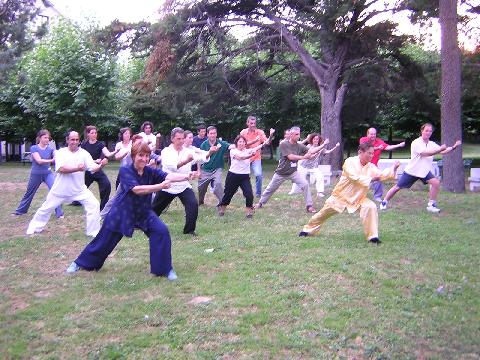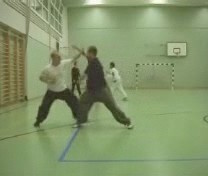THE STUDENT AS PART OF THE PERFECT EQUATION
 Sifu Andrew Barnett
Sifu Andrew Barnett
The following discussion is reproduced from the thread The Student as Part of the Perfect Equation in the Shaolin Wahnam Discussion Forum on 2nd June 2005.
The Student as Part of the Perfect Equation
What part does the student then play in this “perfect equation”? Simple and actually quite logical -- they follow the instructions given by their teacher. -- Andrew Barnett
To achieve the best results when learning, there are three elements which need to be right — the Master (or instructor), the Method and the Student. This is true for anything you wish to learn — not just Chi Kung or Martial Arts. In previous articles on Sifu's home page, information was shared about
- Defining aims and objectives for training Kung Fu
- What to look for in a Master and how to find one
- How to get the best benefits from your training
This article then takes us to the following step.
As a quick reminder, the Master (or instructor) should, at the very least, display the benefits of the Art(s) they are teaching. If they do not then you can justifiably question whether they should be teaching and whether or not the Method they have to offer is genuine.
Sifu Wong has made the search for a competent instructor easy for students seeking the Method(s) offered by Shaolin Wahnam. On his home page Sifu displays a list of certified Shaolin Wahnam instructors. If someone is claiming to teach the methods offered by or on behalf of Shaolin Wahnam and is not on Sifu Wong's list then caution is advised.
In our schools worldwide there are three Arts (Method) being taught — Shaolin Cosmos Chi Kung, Wahnam Taijiquan and Shaolin Kung Fu. Depending on the local instructor one, two or (in rare cases) all three Arts are on offer. What do students of our schools want? The simple answer is — the benefits the Arts are claimed to offer.
 Doing what the teacher says is a logical way to achieving good results. Here, Sifu Wong's students, including some instructors, follow what the teacher teachers so as to derive the best benefits from his teaching
Doing what the teacher says is a logical way to achieving good results. Here, Sifu Wong's students, including some instructors, follow what the teacher teachers so as to derive the best benefits from his teaching
In the case of Shaolin Cosmos Chi Kung these benefits can be arbitrarily classified as good health, vitality, mental clarity and spiritual joy. Even though a vast majority of students are only initially concerned with the lowest levels of attainment -- improved health or recovery from illness -- many discover some of the other benefits very early on in their practice.
There are many parallels in Wahnam Taijiquan and Shaolin Kung Fu training. Both are highly efficient Martial Arts. Their practice also develop health, fitness and character, and can lead to mind expansion and spiritual cultivation -- benefits which are also to be found in Shaolin Cosmos Chi Kung.
As already mentioned, I will assume that the Master or instructor has been found and what they have to teach (the Method) is what the student is looking for. If this were not the case then the Student would be in the wrong place.
What part does the student then play in this “perfect equation”?
Simple and actually quite logical -- they follow the instructions given by their teacher. But so simple the action, so often the inaction or wrong action. Regular, correct practice is the student's contribution to their own success.
But how often and, maybe more important, why do students make the mistake of not practicing correctly and/or trying to be smarter than the Masters?
In Shaolin Cosmos Chi Kung students are told that, to get the best benefits, they should practice what they have learned at least once per day (better twice) for 15 minutes. If a student practices irregularly or incorrectly then it is obvious that the benefits sought will most likely not be achieved. Adding or removing things or otherwise modifying the practice would be an example of trying to be smarter than the Masters. Shaolin Cosmos Chi Kung training is “easy” — relatively speaking.
For Wahnam Taijiquan and Shaolin Kung Fu the student needs more dedication. No-one can become proficient in any Martial Art just by attending a class or course. Even if a class is run twice or more times each week the tendency often becomes to learn more quantity and compromise quality. It is said that true Martial Arts are maximum 5% learning and minimum 95% practice. And the practice cannot be done for the student. The student must practice for themselves.
So why do students make these mistakes? There are many reasons but they can be categorised into the following main groups:
No or inappropriate aims and objectives for trainingI once said that a student with no aims and objectives for practicing will, sooner or later, not practice. And this has often been shown to be true. It is key to set realistic aims and objectives for training and review them at regular intervals. We need a reason for everything we do and a good instructor can help students to set and review their goals.
Spoon-feed mentalityAs an example “I pay for Kung Fu lessons so you must make me a good fighter”. If only it were that simple. That would be like going to a great surgeon and paying them to teach you to be a surgeon too without taking the time to learn and practice the fundamental skills required. Becoming a surgeon requires dedication by the student. They must invest in their own success. The same is true of all high-level Arts and skills.
Mistaking the finger for the moonA trap which many schools fall into. More and more techniques lead to more income. It is certainly easier to keep a student interested (and paying) this way than by concentrating on few techniques and exploring their depth. But the latter method is the one which can lead to mastery. “The Master is not he who merely knows hundreds of techniques; he is the one who masters few techniques (even though he may know hundreds) to such a level of skill that he can use them in any situation”.
And this is just as true for Chi Kung as it is for Martial Arts.
 Free sparring without appropriate preparation is like wanting to run before one can walk. Before one can free spar effectively, he should learn how to apply kungfu techniques skillfully. Combat sequence training, as shown by Sifu Andrew barnett's students in the picture above, is an excellent way to do so.
Free sparring without appropriate preparation is like wanting to run before one can walk. Before one can free spar effectively, he should learn how to apply kungfu techniques skillfully. Combat sequence training, as shown by Sifu Andrew barnett's students in the picture above, is an excellent way to do so.
Wanting to run before they can walk
And how many want to heal others before they themselves are reasonably healthy. How many want to teach before they have even really begun learning (please again see the warning above regarding non-authorised i.e. bogus instructors). And how many want to free spar before they have even learnt any useful techniques or skills.
I remember my Karate days. A white belt with just a few weeks of classes behind me and already free sparring with a black belt. The outcome was pretty clear — bruises, aches, damaged muscles, reduced confidence, aggression. In Shaolin Wahnam sparring is used, as it was traditionally, to confirm the fighting skills and ability of the student and not as a method to learn how to fight. The methodology employed by Shaolin Wahnam enables students to not just play at Kung Fu but to USE Kung Fu — for fighting (if needed) as well as to enhance life.
Remember - Great Arts are extremely rare. If you are lucky enough to have the chance to learn and benefit from them you must play your part -- and at least be a good student.
Andrew Barnett
Shaolin Wahnam Switzerland
http://www.shaolin-wahnam.ch
